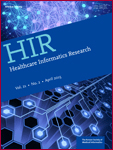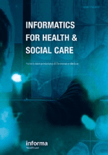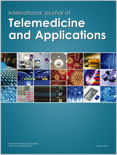
Healthcare Technology Letters
Scope & Guideline
Connecting research and practice in health information management.
Introduction
Aims and Scopes
- Digital Health Innovations:
The journal publishes research on digital health technologies, including telemedicine, mobile health applications, and IoT systems that facilitate patient monitoring and engagement. - Artificial Intelligence Applications:
There is a strong emphasis on the application of machine learning and artificial intelligence in healthcare, addressing problems such as disease classification, risk prediction, and decision support systems. - Medical Imaging and Diagnostics:
Research focused on advanced imaging techniques, including the use of neural networks for image analysis and real-time monitoring, is prevalent, highlighting the importance of accurate diagnostics. - Surgical Technology and Robotics:
The journal explores innovations in surgical technology, including robotic surgery, augmented reality guidance systems, and mixed reality applications that enhance surgical precision and training. - Wearable and Remote Monitoring Technologies:
Studies on wearable devices and remote monitoring systems are common, focusing on their role in chronic disease management and rehabilitation.
Trending and Emerging
- Integration of AI in Patient Care:
Recent papers increasingly explore the integration of artificial intelligence in various aspects of patient care, such as predictive analytics and personalized medicine, showcasing the transformative potential of AI. - Telehealth and Remote Care Solutions:
The significance of telehealth has surged, particularly post-pandemic, with a growing number of studies focused on remote care technologies and their efficacy in enhancing patient access and engagement. - Augmented and Virtual Reality in Surgery:
Research on the use of augmented and virtual reality technologies for surgical training and procedures is on the rise, indicating a trend towards immersive learning and enhanced surgical precision. - Wearable Technology for Health Monitoring:
There is a notable increase in studies related to wearable technology for health monitoring, emphasizing their role in chronic disease management and real-time health data acquisition. - Mental Health Technology Solutions:
Emerging research is focusing on technological solutions for mental health, including AI-driven assessments and mobile applications for self-management, reflecting a growing recognition of mental health's importance.
Declining or Waning
- Conventional Medical Practices:
Research on traditional medical practices and non-technological interventions is becoming less frequent as the focus shifts towards more innovative, tech-driven solutions. - Basic Health Informatics:
There is a noticeable decline in studies that merely address basic health informatics without integrating advanced technologies such as AI or machine learning. - General Healthcare Management:
Papers that discuss general healthcare management strategies without a strong technological component are appearing less frequently, indicating a preference for technology-centric approaches. - Static Rehabilitation Techniques:
Research on static or conventional rehabilitation methods is decreasing, with more emphasis on dynamic, technology-enhanced rehabilitation solutions. - Single-Discipline Approaches:
There is a reduction in studies focusing solely on a single discipline within healthcare, as interdisciplinary approaches that integrate multiple fields are gaining traction.
Similar Journals

Frontiers in Digital Health
Exploring New Horizons in Health InformaticsFrontiers in Digital Health is an innovative peer-reviewed journal published by FRONTIERS MEDIA SA, focusing on the intersection of digital technology and healthcare. As an Open Access journal since 2020, it aims to democratize knowledge by making cutting-edge research freely available to the global community. The journal covers a wide array of topics within the realms of Biomedical Engineering, Health Informatics, and a variety of Computer Science Applications, ensuring interdisciplinary collaboration and advancements. Recognized for its excellence, it holds prestigious rankings in multiple categories, including Q1 in Biomedical Engineering and Q2 in several related fields according to the 2023 metrics. Set in the heart of Switzerland, the journal fosters a comprehensive approach to enhancing digital health technologies, making it an essential resource for researchers, professionals, and students dedicated to improving health outcomes through innovation.

BMJ Health & Care Informatics
Exploring Cutting-Edge Solutions for Modern Health ChallengesBMJ Health & Care Informatics, published by the esteemed BMJ Publishing Group, stands at the forefront of the rapidly evolving field of health informatics. Established as an Open Access journal in 2019, it is dedicated to disseminating high-quality research that enhances the integration of health care with information technologies. With a prominent Q1 ranking in 2023 across categories such as Computer Science Applications, Health Informatics, and Health Information Management, this journal serves as an essential resource for researchers and practitioners alike. The journal is indexed in reputable databases and boasts impressive Scopus ranks—notably, it is placed #43 among Health Informatics journals. The aim is to foster innovation and understanding in health care practices through rigorous research and collaboration. Encompassing a wide spectrum of topics within health data science, usability, and outcomes research, BMJ Health & Care Informatics is pivotal for anyone involved in advancing health care through technology.

JMIR Medical Informatics
Innovating Health Solutions Through Informatic ExcellenceJMIR Medical Informatics is a leading open access journal dedicated to the field of medical informatics, published by JMIR Publications, Inc. since 2013 in Canada. With an impressive impact factor and a distinguished Q2 ranking in both Health Informatics and Health Information Management categories, this journal plays a pivotal role in disseminating cutting-edge research and innovative practices. Covering a wide scope that includes clinical informatics, health information systems, and data analytics, JMIR Medical Informatics provides valuable insights for researchers, practitioners, and policymakers alike. The journal is accessible to a global audience, ensuring that pioneering studies and methodologies reach those who can apply them to enhance health outcomes. With its commitment to advancing the body of knowledge in medical informatics, this journal stands as a vital resource for anyone involved in or studying the intersection of healthcare and technology.

BMC Medical Informatics and Decision Making
Exploring the intersection of technology and healthcare.BMC Medical Informatics and Decision Making is a leading journal in the fields of medical informatics and health policy, published by BMC since its inception in 2001. With an impressive impact factor reflecting its status as a Q1 journal in both Computer Science Applications and Health Informatics, it serves as a vital resource for researchers, professionals, and students dedicated to advancing healthcare through informatics. The journal is committed to disseminating high-quality, peer-reviewed research focused on the innovative use of information technology in healthcare, decision-making processes, and policy formulation. As an Open Access platform, it ensures that findings are widely accessible and can foster collaboration across various disciplines. Positioned at the cutting edge of health informatics, BMC Medical Informatics and Decision Making aims to influence practice and inspire new research directions, making it an essential publication for anyone involved in improving health systems worldwide.

Healthcare Informatics Research
Advancing healthcare through innovative informatics solutions.Healthcare Informatics Research, published by the Korean Society of Medical Informatics, is a leading open access journal that has been advancing the field of healthcare informatics since its inception in 2010. With an ISSN of 2093-3681 and E-ISSN of 2093-369X, the journal provides a vital platform for disseminating high-quality research aimed at improving healthcare systems through innovative informatics solutions. Recognized for its contributions, it holds a Q2 rank in Biomedical Engineering and Q3 rankings in both Health Informatics and Health Information Management for 2023, reflecting its stature within the academic community. The journal is committed to open access, ensuring that research is freely accessible to researchers, professionals, and students worldwide, thus promoting knowledge sharing and collaboration. Located in the dynamic city of Seoul, South Korea, the journal serves as a hub for groundbreaking studies that impact health systems globally, making it an essential resource for those at the forefront of healthcare technology and management.

Applied Clinical Informatics
Bridging the gap between health and technology for better patient care.Applied Clinical Informatics is a leading journal dedicated to the expanding field of health informatics and its applications within clinical settings. Published by GEORG THIEME VERLAG KG in Germany, this journal serves as a pivotal platform for researchers and professionals engaged in the integration of technology and healthcare, aiming to improve patient outcomes through innovative informatics solutions. With a solid Q2 ranking in multiple disciplines including Computer Science Applications, Health Informatics, and Health Information Management, it reflects its prominent position in the academic landscape. The journal provides accessible content while fostering dialogue on key issues and advancements in clinical informatics. Covering a wide array of topics from data management to e-health applications, Applied Clinical Informatics is essential reading for those looking to stay attuned to the latest research and developments from 2009 to 2024, enriching the knowledge base of students, professionals, and researchers worldwide.

International Journal of E-Health and Medical Communications
Fostering collaboration in health informatics and technology.Welcome to the International Journal of E-Health and Medical Communications, a pivotal publication designed to bridge the gap between health informatics and computer science applications. Published by IGI Global, this journal serves as a platform for innovative research and insights into e-health technologies, health communication strategies, and the evolving role of digital tools in enhancing healthcare delivery and management. With an ISSN of 1947-315X and E-ISSN 1947-3168, it caters to an audience keen on advancing the intersection of technology and health, as evidenced by its respectable standings in Scopus rankings—positioned in the 64th percentile in Health Informatics and 63rd in Computer Science Applications. Over its publication history from 2010 to 2024, the journal has consistently contributed to significant discussions and advancements within these fields, highlighted by its Q3 quartile ranking in 2023. Join a community of researchers, professionals, and students dedicated to the ongoing exploration of e-health, as we collectively navigate the complex landscape of healthcare innovation.

Informatics for Health & Social Care
Exploring the future of care through informatics.Informatics for Health & Social Care is a leading journal published by Taylor & Francis Inc, dedicated to the intersection of health informatics and social care. With a strong emphasis on advancing knowledge in the fields of health information management and nursing, this journal has established itself as a vital resource for researchers and professionals seeking to explore innovative applications of informatics to improve patient outcomes and streamline healthcare delivery. Recognized for its influential contributions, it currently holds a Q2 ranking in both Health Informatics and Health Information Management, as well as a prestigious Q1 ranking in Nursing (miscellaneous) for 2023, signifying its critical role within the academic community. The journal is accessible for open access viewing, fostering a broader dissemination of research findings. Released continuously since 1976, it stands as a testament to the evolving landscape of health informatics, addressing pertinent issues and facilitating discussions that shape practices in health and social care delivery.

TECHNOLOGY AND HEALTH CARE
Integrating Innovation for Healthier FuturesTECHNOLOGY AND HEALTH CARE, published by IOS PRESS, stands as a prominent interdisciplinary journal dedicated to the integration of technology within the healthcare sector. With an ISSN of 0928-7329 and an E-ISSN of 1878-7401, this journal has been a vital resource since its inception in 1993, providing insights and advancements in various categories including bioengineering, biomedical engineering, health informatics, and more. Though it currently holds a Q4 classification in several fields and Q3 in others, it actively contributes to the dialogue surrounding innovative methodologies and practices that enhance healthcare delivery. Researchers, professionals, and students will find the journal invaluable for its diverse range of studies that explore the convergence of technology and health. Its commitment to fostering impactful research continues to reinforce its relevance in the evolving landscape of healthcare technology.

International Journal of Telemedicine and Applications
Exploring the future of healthcare delivery through telemedicine.International Journal of Telemedicine and Applications is a premier open-access journal published by HINDAWI LTD, focused on the rapidly evolving field of telemedicine and health informatics. With an ISSN of 1687-6415 and E-ISSN of 1687-6423, this journal has been a key resource for researchers, healthcare professionals, and students since its inception in 2007. Based in Egypt, the journal has established a global presence, reflected in its diverse range of articles that cover topics from computer networks to health information management. Its impact is underscored by its impressive rankings in Scopus, including notable positions such as 34th in Health Informatics and 15th in Health Information Management. The journal is classified in Q2 quartiles for four influential categories, showcasing its relevance and contribution to the field. With an ongoing publication timeline from 2008 to 2024, International Journal of Telemedicine and Applications is crucial for advancing knowledge and practice in telemedicine, offering researchers and practitioners the opportunity to explore innovative solutions in healthcare delivery.